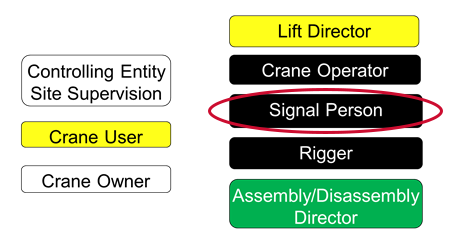March 2022—Fifth in a series of related articles reviewing the roles that have been identified when working with cranes, explaining Signalpersons’ responsibilities, defining their training requirements, and outlining their documentation requirements.
 As stated in our previous articles on crane-related personnel qualifications, the roles on the left side of the graphic are roles that do not have any requirements for qualifications (e.g., competent, certified, or qualified). The roles on the right side, however, do have prescribed qualifications and responsibilities.
As stated in our previous articles on crane-related personnel qualifications, the roles on the left side of the graphic are roles that do not have any requirements for qualifications (e.g., competent, certified, or qualified). The roles on the right side, however, do have prescribed qualifications and responsibilities.
Signal persons can have the greatest impact on jobsites with cranes. In essence, they are the eyes and ears of the operator—especially in situations where the operator cannot see the load. Rightfully, the signal person requirements have grown in OSHA and are an area of focus for ASME.
Under OSHA, the signal person must be a qualified person and is required when the point of operation is not in full view of the operator, the view of the direction of travel is obstructed, or when there are site-specific safety concerns that the operator or person handling the load determines a signal person is necessary.
OSHA allows for two options for qualifying a signal person: Option 1 requires a third-party qualified evaluator (such as CCO certification); or Option 2 relies on an employer’s qualified evaluator. In either case the qualification must be documented. Under Option 1 the qualification is portable, whereas under Option 2 it is not. The qualification documentation must be available at the site and must specify what type of signaling the signal person is qualified to perform.
The signal person must be qualified through an oral or written test and through a practical test. Further, the tests must cover the following content:
- Knowing and understanding the type of signals used
- Understanding the Standard Method for hand signals (if hand signals are used)
- Competently applying the type of signals used
- Having a basic understanding of equipment operation and limitations, including crane dynamics involved in swinging and stopping loads and boom deflection from hoisting loads
- Knowing and understanding the relevant requirements of the regulations
Under ASME, the signal person domain has become an area of focus. ASME B30.5-2021 delineated responsibilities of the signal person, consisting of such items as:
- Directing movement of the crane and/or load
- Signaling equipment (when used)
- Using standard hand or voice signals
- Verifying that special signals (when required) do not conflict with standard signals
- Avoiding commands that results in loads going over people (whenever possible)
It is anticipated that ASME will work to define signal person qualifications in the coming versions of B30.5 and the requirements would likely also contain a written (or audible) and a practical exam.
CCO Signalperson certification provides a proven method to show qualification under Option 1, as outlined above, and is recognized by nearly everyone in the industry. CCO Signalperson certification requires both written and practical testing, is portable from one employer to another, meets all OSHA and ASME requirements, and provides documentation in the form of a CCO certification card.
For more information about CCO Signalperson certification, go to www.nccco.org/SGP.
By Thom Sicklesteel, CEO of the National Commission for the Certification of Crane Operators (NCCCO), a voting member of ASME B30.5, and an member on B30.
View the other articles in this series: